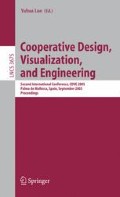Abstract
In the recent years, industrial design programs have shifted from a co-located, sequential process to a globally distributed, concurrent process. Therefore, communication and coordination within and among teams have become major challenges. Surprisingly, several studies demonstrate that collaborative tools exist but are very seldom deployed nor used. Indeed, co-located working sessions remain a critical cooperation milestone for otherwise remote teams. In order to better understand the dynamics of those meetings, and identify what makes them so critical for the design process, we analysed working sessions of aeronautical design teams. This article reports the results of our observations based on three criteria: information types, information flow and interactions performed.
Our study shows the critical importance of private communication channels, and investigates how they relate to the working session’s process. It highlights the need of parallel visualization channels for cross-references, and analyses the use of interactions depending on ownership and context.
Access this chapter
Tax calculation will be finalised at checkout
Purchases are for personal use only
Preview
Unable to display preview. Download preview PDF.
References
Simienuch, C.E., Sinclair, M.: Real time collaboration in design engineering: an expensive fantasy or affordable reality? Behaviour and information technology 18(5), 361–371 (1999)
Prasad, B.: Concurrent Engineering Fundamentals: Integrated Product and Process Organization. Prentice Hall, Englewood Cliffs (1995), ISBN: 0131474634
Guthrie, C.: La Coexistence des Medias de Communication dans le Processus de Conception. Un projet de recherche-action dans une entreprise industrielle Ph.D. Dissertation, GREGOR Université Paris1 Sorbonne, Fr (2004)
McGregor, S.P.: Towards a Prescriptive Design Process for Distributed Design Teams. Ph.D. Dissertation, DMEM University of Strathclyde, Glasgow (2002)
Durstewitz, M., Kiefner, B., Kueke, R., Putkonen, H., Repo, P., Tuikka, T.: Virtual Collaboration Environment for Aircraft Design. In: Proceedings of the Sixth International Conference on Information Visualisation (IV 2002), London, UK, pp. 502–507. IEEE Press, Los Alamitos (2002)
Milne, A.: An Information-Theoretic Approach to the Study of Ubiquitous Computing Workspaces Supporting Geographically Distributed Engineering Design Teams as Group-Users. Ph.D. Dissertation. Stanford Univeristy, US (2005)
Détienne, F., Martin, G., Lavigne, E.: Negotiation in collaborative assessment of design solutions: an empirical study on a Concurrent Engineering process. In: Collaboration Technologies (2000)
Mintzberg, H.: Structured observation as a method to study managerial work. Journal of Management Studies 7(1), 87–105 (1970)
Chan, B.: An experiment in supporting geographically distributed engineering design. Technical Report EDRC 12-69-95, Carnegie Mellon University (1995)
Lécaille, P., Vink, D.: Sociological and Ergonomic Aspects of Virtual World. The DMU-Vi Consortium (Digital Mock-Up Visualisation in Product Conception and Downstream Processes) Ref. DMU-Vi/1.5/3S-CRISTO/D1.5.4 (2000)
Törlind, P., Larsson, A.: Support for Informal Communication in Distributed Engineering Design Teams. In: Proceedings of CIRP 2002, Hong-Kong (2002)
Johanson, B., Fox, A., Winograd, T.: The Interactive Workspaces Project: Experiences with Ubiquitous Computing Rooms. In: IEEE Pervasive Computing Magazine, vol. 1(2) (April-June 2002)
Fischer, M., Hartmann, T., Rank, E., Neuberg, F.: Combining Different Project Modeling Approaches for Effective Support of Multi-Disciplinary Engineering Tasks. In: Proceedings INCITE 2004, Langkawi, Malaysia (2004)
Straitz, N., Tandler, P., Müller-Tomfelde, C., Konomi, S.: Roomware: Towards the next generation of human-computer interaction based on an integrated design of real and virtual worlds. In: Caroll, J. (ed.), pp. 553–578 (2001)
Author information
Authors and Affiliations
Editor information
Editors and Affiliations
Rights and permissions
Copyright information
© 2005 Springer-Verlag Berlin Heidelberg
About this paper
Cite this paper
Laborie, F., Jacquemond, D., Echalier, M. (2005). Cooperation in Highly Distributed Design Processes: Observation of Design Sessions Dynamics. In: Luo, Y. (eds) Cooperative Design, Visualization, and Engineering. CDVE 2005. Lecture Notes in Computer Science, vol 3675. Springer, Berlin, Heidelberg. https://doi.org/10.1007/11555223_5
Download citation
DOI: https://doi.org/10.1007/11555223_5
Publisher Name: Springer, Berlin, Heidelberg
Print ISBN: 978-3-540-28948-7
Online ISBN: 978-3-540-31976-4
eBook Packages: Computer ScienceComputer Science (R0)

